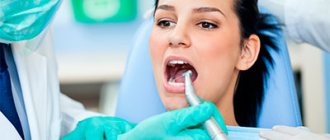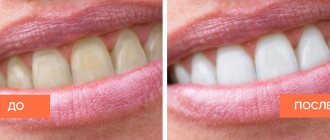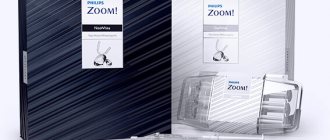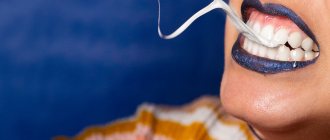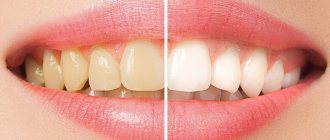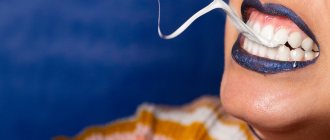Author of the article:
Soldatova Lyudmila Nikolaevna
Candidate of Medical Sciences, Professor of the Department of Clinical Dentistry of the St. Petersburg Medical and Social Institute, Chief Physician of the Alfa-Dent Dental Clinic, St. Petersburg
Cold lamp teeth whitening is one of the most modern ways to lighten enamel. The procedure is carried out using a special LED lamp with cold light.
This method is often confused with whitening with a conventional incandescent lamp, which heats the enamel, which is unsafe for the teeth, as it leads to their cracking, and also causes a lot of unpleasant sensations during the process itself. It is no wonder that patients are often distrustful of lamp bleaching.
The impact of an LED lamp is very different from a standard one; Let's figure out how effective and safe it is, and whether we should be guided by old stereotypes.
The essence of lamp whitening
It cannot be said that in this procedure, whitening occurs thanks to the light produced by the LED lamp. The bottom line is that light is only a catalyst for a chemical reaction between the reagent and the pigments that are inside the enamel and are responsible for its color.
In order to neutralize the yellow tint, a special gel based on hydrogen peroxide is applied to the teeth. Light exposure to this substance activates oxygen, which penetrates the tooth tissue and oxidizes pigments. Thus, light rays stimulate the chemical process, making the procedure safer and faster.
The main advantage of this method is that the light from the LED lamp practically does not heat the enamel, and therefore does not harm it.
Procedure technology.
Teeth whitening with cold light takes about an hour; first, the dentist must prepare the enamel, examine the oral cavity, remove stone and plaque. The process will be complicated by the presence of carious formations; they need to be cured and filled; there is no point in lightening damaged surfaces. It is also recommended that about a week before starting the procedure, you should exclude coloring foods from your diet and brush your mouth only with white toothpastes. If the patient has no diseases or contraindications that would interfere with whitening, the dentist can begin work.
Preparation.
For convenience, a special retainer is used - a retractor, which holds the jaw in the desired position. It helps the patient to relax his mouth and not tense during the entire procedure, and to prevent his lips from cracking, they are moisturized with cream. Exposure to a halogen lamp harms soft tissues, so liquid rubber dam is applied to them. It hardens within 20 seconds, isolating the gums from aggressive influences.
Lightening.
A special whitening gel is applied to the enamel and with the help of the rays of the Beyond device, the surface of the teeth begins to change. The interaction of peroxide and cold light occurs, active oxygen is released, which penetrates into the dentin, destroying dark pigments. After 10 minutes of treatment, the dentist removes the remaining substance and applies a new portion of the solution. This must be repeated three times.
Final.
Any cosmetic procedure affects the structure of the enamel; to restore it, after the action of the Beyond device, the surface of the teeth is covered with special varnishes and fluoride-containing pastes.
Cold teeth whitening: stages
Enamel lightening with gel and a lamp is exclusively an in-office procedure that should be performed by a trusted specialist. Otherwise, you risk damage to the enamel, irritation of the oral mucosa and other problems.
The whitening itself lasts about an hour and is carried out in several stages.
Preparation
Before any whitening, no matter which method you choose, you should prepare your teeth very carefully:
- Firstly, this concerns the elimination of various scratches and chips on the enamel, as well as the treatment of caries. If you don't do this, the active gel may get into the cracks and act too deeply on the tissue, which will cause you a lot of discomfort both during and after the procedure.
- Secondly, pay special attention to fillings and implants; their color will not change due to bleaching, so it is better to choose temporary options and install permanent ones after the procedure. Otherwise, the color of your smile will not be uniformly white.
- Thirdly, mechanical or ultrasonic cleaning is always necessary before whitening; it will remove soft and hard plaque from the teeth, which will help determine the natural color of your enamel as accurately as possible. Cleaning itself will make your smile one or two shades brighter. Next, you can choose the color of the enamel using a special VITA scale. Next, the bleaching itself begins.
Stages
- The first stage begins with preparing the oral cavity for the procedure; this is necessary to protect the soft tissues. The cheeks and lips are isolated using various napkins and films so that the gel does not accidentally come into contact with them when treating teeth. A protective composition is also applied to the gums so that the aggressive effects of the gel do not cause irritation and other problems. The most popular option is liquid rubber dam; the advantage of this composition is that it quickly hardens, forming a dense protective film.
- The second stage is the whitening procedure itself, the surface of the teeth is thoroughly dried and then evenly coated with the active composition. Next, the teeth are irradiated with an LED lamp for about 10 minutes and the gel is removed. If the color is not white enough, the procedure is carried out again. During one visit to the dentist, it is possible to make no more than three approaches.
- Special restorative compounds are applied to the teeth.
The whole procedure takes about an hour. The result is individual for everyone, so do not despair if you did not get the desired color on your first visit; most likely, with repeated procedures you will achieve the desired shade.
How does ZOOM 4 whitening work?
A standard session consists of several steps:
- The doctor examines the oral cavity and determines the desired shade of enamel using the VITA scale.
- A special protective composition is applied to the gums and inner surface of the lips to prevent burns, and the patient is wearing glasses to protect against ultraviolet radiation.
- The surface of the working area is disinfected and dried.
- The first layer of whitening gel is applied, an activating lamp is brought to the mouth - this stage lasts 15-20 minutes.
- The lamp is turned off, and the dried excess composition is carefully removed from the teeth.
- If necessary, the cycle of application and activation with light is repeated up to a maximum of 3 times.
- A remineralizing gel is applied to the enamel to reduce tooth sensitivity.
The standard concentration of the whitening composition is 25% hydrogen peroxide with additional components that reduce the impact on the enamel. This gel is as safe as possible for hardware procedures and does not cause severe irritation.
In advanced cases, one session at the dentist’s office is not enough, and doctors additionally prescribe ZOOM home whitening kits. They usually include a thermoplastic mouthguard + several syringes with a daily dosage of lightening gel.
These sets have several features:
- There are day (9% hydrogen peroxide) and night mouth guards (16% carbamide peroxide);
- The recommended time for wearing the plates is 30 minutes twice a day;
- the standard number of doses is calculated for 9 and 18 applications;
- To control it, you will have to go to the dentist several times a week.
The maximum result of such whitening is 4 shades on the VITA scale, but as an additional measure, home kits have received good reviews from both patients and doctors. At the same time, it is possible to lighten a smile by 8 tones or more without harm to health only in dentistry using patented equipment.
How effective is teeth whitening with LED light?
Modern cold bleaching is a very effective method. Depending on your individual characteristics, in one visit to the dentist you can lighten your tooth enamel by about 6-10 shades. Provided that your teeth have acquired a yellow tint due to food or smoking. If your enamel has acquired a gray tint, lightening with an LED lamp will not give significant results, that is, the shade will change by 2-3 tones. In addition, the procedure will not work if a change in the healthy color of the enamel is caused by taking tetracycline antibiotics or an excess of fluoride in the body.
The results of whitening with an LED lamp can last for several years, depending on the natural shade of the enamel and how carefully you follow your dentist's recommendations.
Why does tooth enamel darken?
To get the most out of lamp whitening, you need to understand the causes of darkening of tooth enamel. In most cases, it is enough to eliminate the negative impact and clean the teeth so that the color of the teeth becomes natural again.
Dentin has a dark shade, which shines through a thin layer of enamel. A fair question arises: how does it happen that dentin darkens if the enamel is strong and can protect the tooth from many negative factors?
The reason is quite simple. It lies in the universal love for solid foods and sour drinks. Seeds, nuts, lemonades and other similar products contribute to the deformation of the upper layer of teeth. Through scratches and chips, pigments easily penetrate into the tooth tissue, staining the dentin.
The main factors influencing the color of teeth:
- The most popular reason is the consumption of foods that contain large amounts of coloring substances. These can be the following things: cranberries, blueberries, beets, strawberries, various candies and sodas, coffee, strong tea and much more. If this is the reason for the darkening of your teeth, then careful hygiene and periodic professional cleaning (once or twice a year) will help.
- Change • Change in enamel color is common in smokers. The main problem here is the tar that is in the cigarette. Together with smoke, they fall on the surface of the teeth and settle in the form of a dark plaque. Gradually, this sediment destroys tooth enamel, which can lead to caries and more serious diseases. In addition, smoking also has a negative impact on your gums. The best option in this case would be to quit smoking completely. If this is not possible for you, try to reduce your cigarette consumption to a minimum and pay more attention to oral hygiene.
- The tooth may darken due to injury, which led to damage to the neurovascular bundle. In this case, consultation with a specialist is necessary. Until the cause is eliminated, whitening will not help lighten the tooth.
- The shade may change due to the removal of the nerve; the darkening may not appear immediately, but also requires the intervention of a specialist.
- Filling a canal can lead to staining of the enamel; it all depends on the material used to fill the hole.
- Progressive caries is an advanced case of ordinary caries. The fact is that if such damage is not eliminated, small black spots will increase, destroying the enamel and then the dentin.
- Teeth may have congenital characteristics that are in no way related to caries or other damage. They can differ in structure, tone, shape, and so on. In some cases, it is possible to change their color only with the help of special overlays - veneers.
- Excess fluoride in the water you drink can lead to fluorosis. At the beginning of the disease, dark spots or chalky streaks appear on the teeth. The progression of the disease leads to the destruction of enamel and then dentin. Whitening such teeth is not possible until you get rid of fluorosis.
- Taking tetracycline antibiotics during pregnancy can negatively affect the condition of the baby's teeth.
Professional laser method
Laser whitening is performed in the dentist's office and is not much different from photo whitening. The difference is that the gel applied to the surface of the teeth begins its action not under the influence of light, but under the influence of a laser. Many experts recognize this method as the best among other types of whitening. But patients themselves leave different reviews regarding laser lightening. But in any case, a consultation with a dentist is necessary, since the laser method also has a number of contraindications.
Benefits of lamp teeth whitening
The main advantage of the LED lamp, which is used for teeth whitening, is the almost complete absence of harm to the patient. This method has passed all clinical trials and is considered one of the safest. Radiation from the source passes through a special filter that neutralizes the negative effects of ultraviolet and infrared radiation. The temperature of the enamel surface during the procedure does not exceed 37.6ºC.
You can also note other advantages of cold whitening:
- Short procedure time;
- The ability to get the desired result in one go;
- The active gel applied to the teeth has a special composition that helps reduce sensitivity to the procedure.
- The system allows you to whiten teeth that have darkened with age or their color is a consequence of fluorosis.
The disadvantage of the procedure is its high cost and a long list of contraindications.
Who is suitable for Amazing White express teeth whitening?
Even such an innovative whitening technology as Amazing White has some contraindications. Firstly, bleaching is not done on children, but it is usually not required at this age. Also, the procedure should not be performed on pregnant women and nursing mothers. Increased photosensitivity and taking medications that affect this indicator also make it impossible to lighten the enamel. In addition, of course, Amazing White express teeth whitening, like many other dental procedures, is not performed in case of significant dental caries.
There are other factors in which teeth whitening is contraindicated:
- allergy
- enamel defects
- gum and periodontal diseases
- lesions of hard tissues in the cervical area of the tooth
Only a dentist can determine whether a patient has contraindications to whitening. Sometimes it is advisable to carry out the procedure after complex treatment. You shouldn’t rush and turn a blind eye to existing dental problems, as in this case, whitening can cause complications.
Contraindications
You should not resort to whitening with an LED lamp in the following cases:
- high sensitivity of teeth;
- defects on enamel;
- pregnancy or lactation (there are other methods);
- intolerance to the active components that make up the gel;
- fixed dentures, crowns or a large number of fillings;
- The procedure is also not recommended for children under 16 years of age;
- caries, periodontitis and other diseases.
In the latter case, the ban is temporary, since the procedure can be carried out after you have treated your teeth.
Types of whitening and contraindications
A dentist will help you choose the optimal whitening method for each patient. He will find out the reason why the teeth changed their color and interview the patient about contraindications:
- children under 18 years of age;
- any trimester of pregnancy;
- lactation period;
- individual allergic reaction;
- multiple fillings, prosthetics in the smile line (if the patient does not plan to change these fillings and crowns in the future).
Before you start whitening, you need to perform oral hygiene. Exposure to the Philips Zoom lamp! WhiteSpeed (Zoom 4) is suitable for most patients, but you must get your doctor's approval before using it.
How to save the result
Once you've gotten the whiteness you wanted, don't forget that your teeth now need more careful care. For a week, it is best to follow a clear (white) diet, the essence of which is to exclude coloring or very hot foods. It is also better to reduce your cigarette consumption.
In addition, professional products from the ASEPTA series for oral care will help you. They will prevent the appearance of yellow plaque, caries and other troubles, for example, ASEPTA Sensitive toothpaste will help reduce tooth sensitivity after the procedure. In the future, you can use ASEPTA PLUS Remineralization or Gentle Whitening toothpaste to maintain a snow-white and healthy smile.
Sources:
- Report on determining/confirming the preventive properties of toothpaste “ASEPTA PLUS” GENTLE WHITENING” Author: doctor-researcher A.A. Leontyev, head Department of Preventive Dentistry, Doctor of Medical Sciences, Professor S.B. Ulitovsky First St. Petersburg State Medical University named after. acad. I.P. Pavlova, Department of Preventive Dentistry
- Report on the determination/confirmation of the preventive properties of personal oral hygiene products “ASEPTA PLUS” Remineralization doctor-researcher A.A. Leontyev, head Department of Preventive Dentistry, Doctor of Medical Sciences, Professor S.B. Ulitovsky First St. Petersburg State Medical University named after. acad. I.P. Pavlova, Department of Preventive Dentistry
- Clinical studies of antisensitive toothpaste “Asepta Sensitive” (A.A. Leontyev, O.V. Kalinina, S.B. Ulitovsky) A.A. LEONTIEV, dentist O.V. KALININA, dentist S.B. ULITOVSKY, Doctor of Medical Sciences, Prof. Department of Therapeutic Dentistry, St. Petersburg State Medical University named after. acad. I.P. Pavlova
- Report on determining/confirming the preventive properties of toothpaste “ASEPTA PLUS” COFFEE and TOBACCO Author: doctor-researcher A.A. Leontyev, head Department of Preventive Dentistry, Doctor of Medical Sciences, Professor S.B. Ulitovsky. First St. Petersburg State Medical University named after. acad. I.P. Pavlova, Department of Preventive Dentistry
Pros and cons of ZOOM 4 whitening
ZOOM 4
Advantages of this technique:
- guaranteed enamel lightening by 8-10 tones;
- long-term effect - with proper daily hygiene and a balanced diet, teeth begin to darken no earlier than after 4 years;
- the session lasts 45 minutes, which is 30% faster than the previous generation devices;
- the upper layers of enamel are not destroyed, as with chemical bleaching;
- clinically proven results in patients with advanced fluorosis and tetracycline teeth;
- The device's lamp has a cold halogen light, the risk of gum burns is minimal.
There are not many disadvantages to the procedure:
- an impressive list of contraindications;
- slight likelihood of increased tooth sensitivity after the session;
- if anterior fillings and dentures are installed, they will have to be changed to lighter ones so that they do not stand out;
- high cost of the service.


